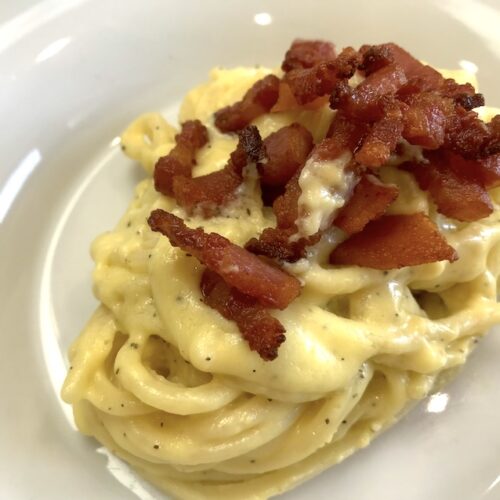
Equipment
- metal bowl
- whisk
Ingredients
- 3 large eggs (1 egg + 2 egg yolk), see notes
- 1-1½ cup grated pecorino romano cheese (100-150g ), see notes
- 200 g guanciale (about 7 oz), cut in cubes or strips, see notes
- 200 g spaghetti (about 1/2 lb)
- pepper
- pasta water
How I Make It
Guanciale (or pancetta or bacon)
- Chop the guanciale (or bacon or pancetta) into cubes or strips. Pieces will shrink a little after you cook them, so don't cut too small.
- Starting in a cold pan, cook the guanciale until browned, and the fat has rendered out. Depending on how much fat you trimmed off, or how fatty the cut you're using is, you may need to add a little olive oil to make sure there's enough oil for this dish. You will need about 4 tablespoons (1/4 cup) of oil. If using bacon, this usally isn't a problem as bacon renders out a lot of fat. Remove the guanciale from the oil when cooked to your liking, and set aside. Reserve the oil.
Egg-cheese mixture
- In a metal bowl, whisk together egg, egg yolk, cheese, and pepper.
- Pour about 1-2 tablespoon of the reserved oil into the mixture, and whisk to combine.
- Boil a pot of water and place the mixture over the steam. Use kitchen mits or towel to hold the bowl with one hand, and use the other hand to whisk the mixture vigorously for about 30-60 seconds, until the mixture is smooth and silky. You can do this over the pot of pasta while it is cooking (becareful your pasta doesn't boil over under your bowl) or over a separate pot of water (which might be less stressful).This emulsification process will start cook the eggs and melt the cheese, helping to prevent "scrambled eggs" in your pasta later. If the sauce is too thick, add a little pasta cooking water a little bit at a time (slowly! so your eggs don't scramble), and keep whisking vigorously.
Cook pasta until just before al dente
- When the water is boiling, add spaghetti and follow cooking time as instructed on the box. Cook the pasta until just before al dente.
- Just before time to remove the pasta, warm up a couple of tablespoons of the reserved oil on low/low-medium heat - we're not looking for frying temperature.
- When the pasta is almost al dente, pull it from the water and add directly to the oil. It's ok if some water comes with it. Working quickly, stir the pasta vigorously for about 3 minutes in the oil to emulsify the fat. Add a little more pasta water if it is too dry. The water & oil will turn into a milky-looking emulsification. This is good and will be the basis of your sauce so continue until you achieve the consistency you like (don't go nuts though or your end result will be too watery!).
- Turn off the heat. Add the egg-cheese sauce and mix through, continuously mixing and tossing. Be attentive, work quickly, and keep it moving or you might get that undesirable "scrambled egg" texture. If the sauce feels a little dry, add a little more pasta water until you have the consistency you like.Taste & adjust for salt and pepper.
- Top the finished pasta with the guanciale pieces and a little more cheese if desired.
- Serve and eat IMMEDIATELY. This is not a dish you save for later. Leftovers will not be as good!
Notes
- Try to get grated Pecorino Romano, instead of shaved or shredded. It will incorporate easier in the sauce. Delis that sell cheeses will usually grate it for you. I've included the weight (150g) as well since 1 1/2 cup of cheese can translator to a different amount if it is shaved or shredded.
- You can use parmesan as a substitute for pecorino, it will taste a little different, but still good. You can also do a combination of both. Always use high quality cheese whichever one you choose.
- Guanciale can be found in Italian delis, but if you can't get Guanciale, you can substitute with pancetta. Bacon will also work, but since bacon is smoked, it will taste different than the 'traditional' carbonara.
- You will need oil from the cooked Guanciale or pancetta - depending on how fat the cut you have comes with, and how much fat you've trimmed off, you may need to add a little olive oil to ensure you have enough oil to complete this dish.